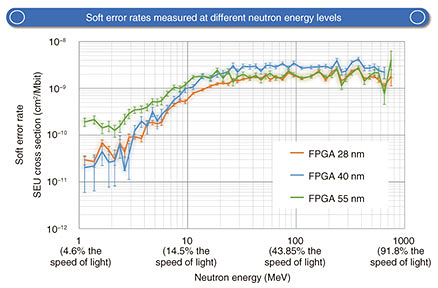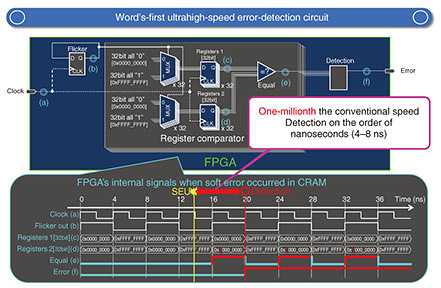 |
|||||||||
|
|
|||||||||
|
Short Reports Vol. 19, No. 4, pp. 75–77, Apr. 2021. https://doi.org/10.53829/ntr202104sr2 First Successful Measurement of Neutron Energy Dependence of Semiconductor Soft Errors1. IntroductionNTT, Nagoya University, and Hokkaido University joined forces and successfully measured semiconductor soft error*1 rates*2 at continuously varying neutron energies from 1 to 800 MeV. The findings reveal, for the first time, the complete picture of the energy dependence of semiconductor soft errors. Data on soft-error-rate dependence on neutron energy are critical when studying the impact of cosmic rays on semiconductors and investigating countermeasures because the number of soft errors is heavily dependent on the incoming neutron energy. However, it has been impossible to measure data that have a wide and continuous energy range. Therefore, the soft error rates measured to date have been limited to several discrete neutron energy levels. We developed an ultrahigh-speed error-detection circuit that enables us to precisely measure flight times of neutrons arriving at the semiconductor even if the velocities are close to the speed of light. From the flight time, we can deduce the speed of the neutrons causing the soft errors. The circuit makes it possible to measure soft errors caused by neutrons across an extremely wide range of energies up to 800 MeV. Soft error rates, which we measured successfully, are among the most basic and critical data to predict the number of soft errors caused by neutrons in various environments not only at ground level but also at high altitudes, in space, or even on another planet. The data will be useful in a variety of fields, e.g., evaluation of semiconductor reliability in space stations, study of soft-error prevention measures to be taken in semiconductor materials, soft-error tests using an accelerator, and simulation of the process in which soft errors occur. The research results were published in IEEE Transactions on Nuclear Science on November 19, 2020 [1, 2].
2. Research resultsIn this research, we have developed a high-speed error-detection circuit that can detect soft errors within several nanoseconds (nanosecond = one billionth of a second) so that we can identify the energy of a neutron close to the speed of light using a time-of-flight method. With this method, measuring the traveling time of a neutron from a neutron-production target to a device, we can calculate the velocity of the neutron, hence its energy. Using the 800-MeV high-energy proton linear accelerator at Los Alamos National Laboratory, USA, we conducted experiments with three field programmable gate arrays (FPGAs) with different design rules: 28, 40, and 55 nm. We were able to measure soft error rates at continuous energies with very high-energy resolution, as shown in Fig. 1.
It was found that the energy dependence of soft error rates was more or less similar for the three FPGAs. The soft error rate increased rapidly from 3 to 20 MeV but was almost constant thereafter. Though upon closer examination, slight variations in the rate among the three FPGAs were found. 3. Key technical points(1) Time-of-flight method The (kinetic) energy E of a neutron can be determined by measuring the neutron speed, i.e., time it takes for a neutron to travel a certain distance. It is expressed by Eq. (1) based on the special theory of relativity using the energy of the neutron having speed v and rest mass m0, where c is the speed of light.
In our experiments, neutrons were generated within an extremely short time of 125 picoseconds (picosecond = one trillionth of a second), and the time taken for them to fly about 20 meters was measured. This made it possible to measure the energy of a neutron traveling at a speed close to that of light. (2) Ultrahigh-speed error-detection circuit (NTT, Nagoya University, and Hokkaido University) Neutrons that cause soft errors travel at extremely high speed. To measure their energies, it is necessary to detect soft errors at nanosecond resolution. However, commonly used memories, such as static random access memory (SRAM), read data sequentially, thus take several milliseconds to scan the amount of data (megabit order) sufficient for soft-error detection. This means that the time-of-flight method cannot be used in such memory to determine the energy of high-energy neutrons. To solve this problem, we developed a circuit that can detect malfunctions caused by soft errors in logic circuits with extraordinary speed (Fig. 2). By using this circuit, we were able to detect a soft error that occurred in configuration random access memories (CRAMs). Each CRAM has a capacity of a few tens of megabits and is made up an FPGA circuit. Our circuit can detect a soft error at a speed equivalent to the operational speed of the FPGA, which is on the order of nanoseconds. By using this high-speed error-detection circuit, we can now identify the energy of neutrons that cause soft errors.
(3) The 800-MeV high-energy proton accelerator at Los Alamos National Laboratory Using the high-energy accelerator at Los Alamos National Laboratory, we conducted experiments in which we measured soft error rates at continuous energies using our ultrahigh-speed error-detection circuit. The accelerator accelerates protons up to 800 MeV, which is about 90% the speed of light, and the protons hit the tungsten target and generate high-energy neutrons. The energy distribution of neutrons generated in this facility is similar to that in nature of up to 800 MeV. A neutron detector, called a fission chamber, has been used in this facility to measure the energy spectrum of neutrons up to 800 MeV. 4. Future prospectsThe obtained data enable us to calculate the number of soft errors caused by neutrons in any environment, not only on earth but also at high altitudes, in space, or even on another planet. In addition, the data will be useful for selecting an optimal accelerator for soft-error tests, development of neutron sources for soft-error tests, studies of measures to prevent soft errors in semiconductor devices, and simulation of the process in which soft errors occur. The data have the potential to lead to dramatic advances in research and development in a variety of fields. References
For inquiries:Public Relations Section, Planning Department, NTT Information Network Laboratory Group |
|||||||||










 ĦĦĦĦĦĦĦĦEq. (1)
ĦĦĦĦĦĦĦĦEq. (1)